‘Who No : Letters From Alice May Williams’ was written to accompany the current exhibition at Michael Lett, featuring works by a number of artists including Simon Denny, Michael Parekowhai, and et al.
In one of those fortuitous coincidences, Michael and I discovered a fondness for a single letter by an Auckland woman who was writing to California’s Mount Wilson Observatory in the early 1930s. You could call it Outsider Art if you wanted. So I went on a search for just who this woman was …
The Museum of Jurassic Technology in Culver City provided the complete text of all of the existing letters and I tracked down as much information as I could find locally.
The following essay is the result. It is an odd look at a piece of New Zealand and Auckland history, South Island lighthouses, and newspaper archives. It is a story which has everything – alien children, Martians, delusions on Karangahape Road, and a woman whose life I found both tragic and enigmatic.
Everything in it is true.
David Herkt
----
WHO NO: LETTERS FROM ALICE MAY WILLIAMS
A PRELIMINARY ENQUIRY
David Herkt
1.
In 1931, Alice May Williams of Auckland, New Zealand began writing a series of letters to Dr Edison Pettit and Dr Seth B. Nicholson, astronomers at the Mount Wilson Observatory in Pasadena, California.
The five surviving letters outline her knowledge of sky-machines, bodies linked by radio to souls, and give instructions for the building of devices in which people might travel between planets.
They also contain glimpses of Alice’s daily life in a series of rented rooms in Mt Eden, Karangahape Road and Ponsonby, where newspaper advertisements communicated directly to her, extraterrestrial voices addressed her in the cinema, and landladies mocked her to her face.
It was in these fraught domestic circumstances that Alice May Williams conducted her correspondence with a pair of famous scientists whom she regarded as her equals in the exploration of space.
2.

Illustration 1: Alice May Williams, Page 1, Letter #0001 [Museum of Jurassic Technology]
Letter #0001
Auckland
Tuesday July 7th [1931]
Dr. Edison Petit
Dr. Seth B. NicholsonDear Gentlemen,
Some weeks ago I wrote you a letter. Not yet having heard from you I was wondering if you received my letter I wrote you from Homai. Since, I have shifted from Homai, to Auckland. So I thought I would send you my new address. I want to tell you I am not after money & I am not a fraud. I believe I have some knowledge which you gentlemen should have. If I die my knowledge may die with me, & no one may ever have the same knowledge again. Because if people hear talking they want stick, they go & do away with their selves. I have gone through frightful things still I go through it & I am beginning to get knowledge. I would write down & tell you what I no. But I would sooner wait till I hear from you. Because you are both strangers to me & my letter may go astray. When one writes one needs peace & quietness
I have got half a house with another woman some years older. She will not let me sit quite a moment it is terriable she keeps wanting to no the inds & outs of everythink. She keeps running up & down the stairs in & out of the doors slamming them about & keeps wanting to talk & keeps wanting me to get ready to go out. It is awfull I dont no wether I am standing on my head or feet & still I am going through that treatment I told you. At times somethink works my mouth to talk out loud & I have got to be carefull of her hearing as she thinks I am mad, & makes all sorts of fun of me to people. So in a few weeks I may have a little house of my own, & in the meantime I may hear news of you people & then I will be able to sit down & write quietly without interference. you no yourself if people interfere with you you can’t do your work properly. I do want to tell you somethink because the entrance into the other world is worked different to what you ever thought & you will get a shock. When I tell you I dont want no money from you. It wont do you no harm to have my knowledge. So I will now conclude hoping you gentlemen are living & in the very best of health as I hear that people are dying in america, with the very hot weather they are having.
I Remain
Yours Sincerely
Alice WilliamsMrs. Alice May Williams
No. 18 Norman Street
Rocky Nook off Dominion Rd
Auckland. NZ.
P.S. Please excuse writing & mistakes as this lady is worrying me to get ready to go out. Please keep my letters secret till I tell you what I no. Then you can do what you like. A.W.
3.
The letters of Alice May Williams form part of a permanent exhibit devoted to letters written to the Mount Wilson Observatory, 1915–1935, in the Museum of Jurassic Technology, a ‘wunderkammer’ museum located at 9341 Venice Boulevard, in Culver City, Los Angeles, California.
The Mount Wilson Observatory’s telescopes had the same public status in the early 20th Century as radio-telescopes had in the mid 20thCentury, and the Hubble Space Telescope in the 1990s.
A 60 inch reflecting telescope had been installed at Mount Wilson in 1908, followed by the 100 inch instrument nine years later. A steady stream of discoveries excited the public: new moons were located around Jupiter; observational proof was provided that nebulous objects observed in the night sky were actually galaxies beyond the Milky Way; the Red Shift phenomenon was related to the distance of a galaxy from earth; the universe was revealed not as static but as expanding.

Illustration 2: “The World’s Largest Glass Eye” The 100 inch telescope at the Mount Wilson Observatory [Auckland Star, Volume LXII, Issue 150, 27 June 1931, Page 12]
These discoveries were widely reported. As a consequence of this global publicity, the Mount Wilson Observatory received a volume of correspondence from a large range of people in many different countries expressing congratulations, interest or wishing to share their own views and theories.
A collection of 33 such letters was gathered by the Observatory’s Chief Solar Observer, Joe Hickox in the 1940s and forms the basis of the MJT collection. Five of the Alice May Williams letters (MJT Catalogue #0001, #0002, #0003, #0005 and #0006 – letter #4 is missing) were preserved.
Though almost entirely unknown in New Zealand, Alice’s letters have had a healthy referential life elsewhere. They feature in the MJT publication ‘No One May Ever Have The Same Knowledge Again’ (ed. Sarah Simons) and selections are displayed on the MJT website. They are quoted and excerpted (especially #0001) on numerous internet sites as curiosities or examples of ‘outsider art’.
The Alice May Williams letters have also formed the basis of an opera ‘Wunderkabinet’ by African-American composer, performer and audio artist, Pamela Z, which premiered in 2005 in San Francisco with subsequent performances in Los Angeles and Ontario, Canada.
In Z’s opera Alice May Williams is envisaged travelling from New Zealand to Los Angeles “…in search of the scientists of the Mount Wilson Observatory to whom she has been sending abundant correspondence, only to find herself in a strange cabinet of curiosities…”
4.
Little attention has been paid to Alice May Williams personally. Her letters are exhibits, symptoms, or curiosa. The real woman has been unjustifiably neglected. Her background has been unexplored. Her life disregarded.
We do not know how old she was at the time of her letters. We know she lived in New Zealand’s capital city, Wellington as an adolescent:
“When I was 13 years of age their was a large earthquake or tremble in Wellington. I was in the 2nd storey of a 3 storied factory, & I can remember that was just what it felt like.”(#0002).
If the 13 year old Alice was at work when this earthquake struck, we can assume she was not highly educated and probably came from a poor urban background. An Alice May Williams is recorded as having attended the Church of Christ Sunday School in Wellington’s working class suburb of Newtown in 1912.
In the same letter, Alice provides the only written description she makes of herself:
“I have nice dark hair & far younger than my grey haired landlady. no disrespest to grey hair because I might soon start to go grey, used to put every one up to play my hair out. It is a nice nut brown colour only I have spoilt it by hacking it about & taken the nice colour off through peoples spite.” (#0002)
Alice may have had nervous or verbal tics, related to her illness.
“But I do hate it saying who no [“Who knows?”], through me at times so people can hear, & it wont stop. It keeps working me up to say who no all the time, in the house, but not in the street my husband doses carry on & he wont stop he thinks I am saying it on purpose.”(#0003)
Alice explained the origin of her interest in astronomy to Dr Seth B. Nicholson:
“When I used to live on the lighthouse I used to live out side a great deal. & I watched everythink going on in the sky taught my-self & also had a great deal of enlightment” (#0005)
Alice refers to the fact that she had lived in a lighthouse three times in the correspondence and these biographical statements should not be taken metaphorically or symptomatically. She tells Dr Nicholson:
“We used to be on a lighthouse down south Island. I used to go outside a great deal at night.” (#0003)
She also sends Dr Nicholson photographs of herself, which have not survived
“I am sending you a 2 snaps of me taken with the other keepers wife on the lighthouse 5 years ago.” (#0002)
Accessible records of early 20th Century New Zealand lighthouse keepers are patchy, but a Hugh Owen Williams is recorded as being an assistant lighthouse keeper for the Cape Foulwind lighthouse on the West Coast of the South Island in the period 1922 to 1924.
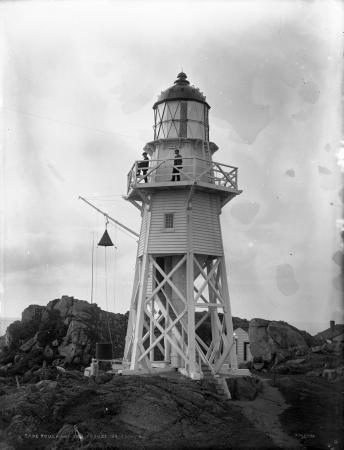
Illustration 3: Cape Foulwind Lighthouse, Westport, unknown date. [Alexander Turnbull Library, National Library of New Zealand Te Puna Mätauraga o Aotearoa]
Surrounded by cliffs, the site was selected in 1874 and a timber building, 36 feet high, sited 190 feet above sea-level, was constructed. The lamp was first lit in 1876. The light revolved every 30 seconds and it could be seen for 19.5 nautical miles.
The lighthouse was replaced in 1926 with an automatic light, and the keepers, including Hugh Williams, were withdrawn.
It isn’t known where Hugh Williams was reassigned. His relationship, if any, to Alice also cannot be confirmed.
5.
Much of the Alice May Williams correspondence is devoted to her speculations and theories of the nature of the solar system, especially in the two longest letters (#0003 and #0005) sent to Dr Nicholson:
“Their are holes in certain places in the sky. You may be able to see certain countries of heaven through the holes. Thats what you think Planets.” (#0005).
Much of her theorising is concerned with extraterrestrial beings.
“The Planet mars is inhabited by human spirits like us can talk eat & drink wear clothes, but have great power. They are somethink people of this earth have never seen. They are kept to do work overhead. They also work our wireless gramphones, machinery, Moving Pictures Talking Pictures and all that sort of thing.” (#0003)
Alice’s Martians also have machines that operate in the air, much like elevators. They are circular and contain rooms with furnishings.
“I will give you a design of one of their machines. They are round like the moon with airtight shutter at the front, glass. The machine must be built with some light material, airproof fireproof, waterproof. The inside must be like a room, 2 beds tables & chairs. Places to keep stores for 6 months or more. Salt, must not be forgotten. flour, tin meat, potatoes, must not carry strong drink can carry money in gold or gold. must have condenser to condense the air outside, two long pipes like tubes inside one to let bad air out & one to let fresh air in must be worked elevater style to run up & down or along & accross must have a small lavatory built in with a airtight sit & the door always kept close when not in use must not throw anythink into the air when the machine is in use, no slops of any kind. must have a tank built in for water for use while on the Journey Plenty fresh water, must not forget cooking utensils. something to cook with. At night time let up with a nice bright light. light attracts. If oil is used a large fireproof tank must be built to hold plenty of oil. Everythink must be built of the lightest of material.” (#0005)
Alice has seen and communicated with the people in these machines:
“…two people a man & woman very tall fair people they where singing a moon song…” (#0003)
And ...
“…three brothers… one looked like a clown they had like pipes set on a table in the centre of the room & they where alight like gas…” (#0003).
She has tasted their food and played with their children. The children, who call her Al, especially delight her:
”Fancy a dear pretty little child of two years thinking he his great showing me his self to Al & having fun dear little baby young girls & men show me their selves like in a photo.“ (#0003)
These beings seem capable of communicating to her directly, especially when Alice was in what she referred to as a “sleep trance”. (#0003)
6.
The major traceable factual sources of Alice’s scientific theories appear to be articles published in the Auckland Star in the early 1930s.
It is probable that she kept a file or a scrapbook containing a number of these clippings, to judge from the time-delay between their appearance in the daily newspaper and Alice’s reference to them in her letters.
Alice begins letter #0003 by copying out an uncredited heading from an Auckland Star story published on 7th February 1931. “Climate of the moon. Absence of atmosphere. Great extremes of temperature, Can life exist on other planets?’’

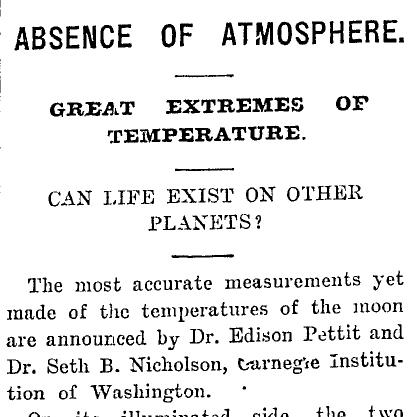
Illustrations 4a and 4b. Climate of The Moon. [Auckland Star, Volume LXII, Issue 32, 7 February 1931, Page 7]
The story also quotes both Drs Pettit and Nicholson, the two Mount Wilson astronomers to whom Alice would direct her correspondence.
This may have even been the story that initiated Alice’s correspondence.
The other Auckland Star story which featured in the letters is from 31stOctober 1931, entitled ‘Another Planet? Early Discovery Predicted’. Pluto had been discovered the previous year, 1930, and the story is a speculation on the existence of yet another planet.
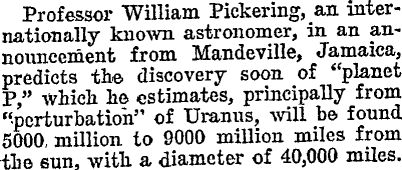

Illustrations 5a and 5b: Auckland Star, Volume LXII, Issue 258, 31 October 1931, Page 9
In the same letter (#0003), Alice quotes Professor William Pickering’s calculation of the orbit of his proposed new planet – only to promptly disagree with it
“Professor William Pickering computes that the new planet takes 656 years to make one circuit around the sun in an elliptical orbit. no such thing. let me tell you their are all different suns.”
Alice had her own knowledge and she gave it weight, even against substantial scientific talent.
7.
It is clear that Alice was a reader of signs and portents, and not only those in the heavens. She wrote on Jan 29th 1933.
“Some months ago I seen in a advert in the Star. A. W. – letter at Post Office; leaving N.Z. Urgent stupitd stupid,” (#0002)
Three months earlier, in the Personal Columns of the Auckland Star for the 14th and 15th of October 1932 an advertisement had appeared:

Illustration 6. Personal Column. [Auckland Star, Volume LXIII, Issue 244, 14 October 1932, Page 1]
Alice presumed that this published text related to her.
“[T]he next day, I went down to the Post Office it was a rainy day. The man over the counter snapped my head off he said no letters for that name. that night the same advert. The next day the Mariposa sailed for California. The landladys husband brother in law is somethink over the letters in the P.O. I dont no wether he stopped it if it was for me he hated one night from the start I went to Wellington for a trip & his wife wanted my husband to put me out & board with them. It didnt work because I have been a good wife to him & he would have to keep me. In that day when I got to the P. Office 3 well dressed men came up & looked hard right into my face as if they wanted to speak, when I came out they where gone, when I got up the street a bit they where gone, when I got up the street a bit they standing by a shop window & stared into my face. I no they were strangers.” (#0002)”
8.
Alice wrote her letters to Mount Wilson in a two year period from three Auckland addresses.
In Letter #0001 Alice explains that she had previously lived in Homai, then a small town between Manurewa and Wiri, just south of Auckland City. Alice had written from Homai to Mount Wilson but this initial letter has not survived. Its content is unknown.
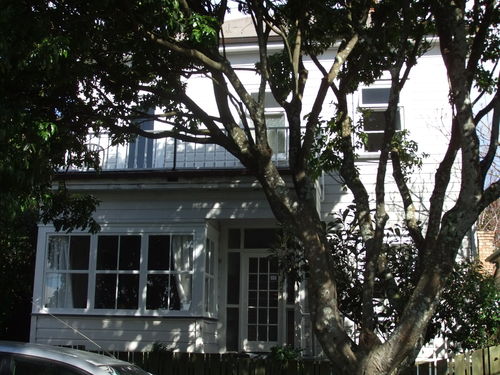
Illustration 7: 18 Norman St, Rocky Nook, Mt Eden, now 18 Tawari St, Mt Eden. “I have got half a house with another woman some years older. She will not let me sit quite a moment it is terriable she keeps wanting to no the inds & outs of everythink.” (#0001)
Letter # 0001 itself was written on Tuesday, July 7th 1931, when Alice was sharing “half a house” with another woman “some years older” at 18 Norman St (since renamed Tawari Street), in the Rocky Nook subdivision of Mt Eden. It was a double-storey house (“She keeps running up and down the stairs”). She soon hopes to have a “little place” by herself. Alice is undergoing some sort of “treatment” that she had previously mentioned in her missing first letter.
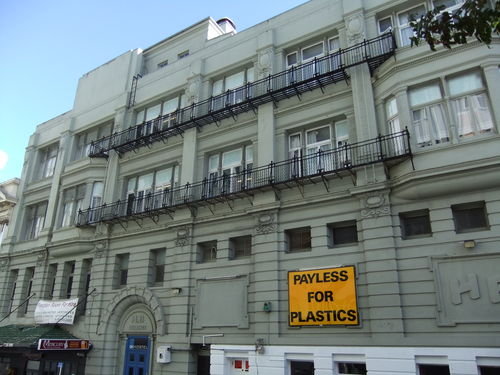
Illustration 8: 246 Karangahape Rd, Newton (Side View). The street may have been renumbered after the 1930s, so it should be emphasised that is a tentative identification of the building to which Alice refers in letters #0003, #0005, and #0006.
Letters #0003, #0005, and #0006 were written from 246 Karangahape Rd, Newton, “(over J. Bells Furniture Shop)”. Alice lived here in December of 1931 (#0006) and probably for some time thereafter. Letters #0003 and #0004 contain the address, but are not dated.
It is clear from Alice’s letters that this is a building with a number of floors. In the later letter #0002 Alice refers to a woman living “on the top” floor who had the same name as her, and who she thought may have been receiving her mail in error. Alice probably shared a first floor flat with another woman, whom she describes as treating her as a servant, making her do the washing. She describes this woman as her landlady and suspects her of steaming open Alice’s letters. The flat was “damp”.
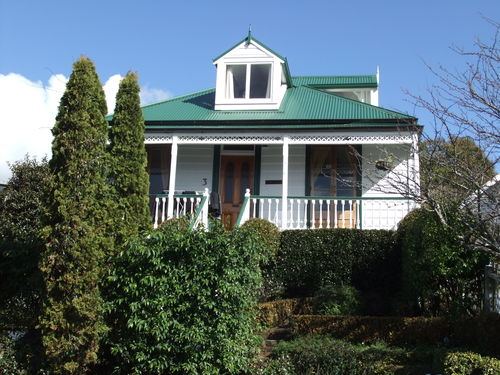
Illustration 9. 3 Georgina St, College Hill, formerly 3 George St. “I have shifted into a house in a quite street it is a old one. but the neighbours are so quite & nice.” (#0002)
The final Alice Letter (#0002) was written on Jan 29th 1933 from 3 George St (since renamed Georgina St), Ponsonby. For Alice, it is cheaper accommodation in an older style house. Alice’s neighbours are far more congenial. She has possibly left her husband in the Karangahape Road flat –“my husband wouldn’t shift out”. (#0002)
9.
With minimal resources, in a country far from the scientific centres of the world, Alice May Williams devoted a sustained attention to advances in astronomy.
A watcher of the skies since childhood, her sense of the heavens had been intensified by a period in the late 1920s living with her husband in a lighthouse on a remote stretch of the New Zealand coast.
She collected newspaper stories of contemporary astronomical discoveries, utilising them as a basis for agreement or disagreement, and offering her own interpretations of the data. She was conversant with publicised advances in the subject and was in direct epistolary communication with two of the major astronomical researchers of her time.
Alice’s study of the skies was also paralleled by the necessity of interpreting the strange world in which she found herself on a daily basis, where extraplanetary beings communicated with her, machines shuttled between heaven and the earth, messages were delivered from strange sources, and she was sustained by the love and laughter of alien children.
Alice May Williams was also a universe.
--------------------------------------
Acknowledgments
I am grateful to the Museum of Jurassic Technology, in particular Hana van der Steur, who provided transcripts and high-quality scans of all the Alice May Williams correspondence, including the previously unpublished letters. Hana’s assistance and generosity was much valued.
I am also indebted to the research facilities of the Auckland Public Library and to the PapersPast project of the National Library of New Zealand/Te Puna Mātauranga o Aotearoa.
I also wish to thank Michael Lett and Jacob terre.
© David Herkt 2012